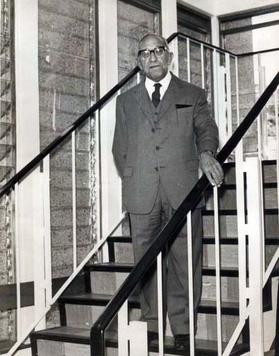Frances Margaret Leighton facts for kids
Frances Margaret Leighton (born March 8, 1909 – died January 8, 2006) was a botanist and teacher from South Africa. After finishing her Master's degree at Rhodes University in 1931, she worked at the Bolus Herbarium until 1947. She mostly studied plants called monocots, and her work helped us understand Ornithogalum and Agapanthus flowers better.
Frances married another botanist, William Edwyn Isaac, in 1936. They had three children. In the 1950s, Frances was active in a group called the Black Sash. They protested against Apartheid, which was a system of unfair rules in South Africa. In 1961, she moved to Nairobi and studied sea grasses along the coast of East Africa. Frances and William later retired to Mornington Peninsula in Australia. There, Frances joined groups that worked to protect nature. She was even named an honorary botanist by a society that protects Australia's native plants and animals.
Contents
Frances Leighton's Life and Work
Frances was born in King William's Town, South Africa. She went to Rhodes University from 1927 to 1931. After getting her Master of Science degree, she started working at the Bolus Herbarium in 1931. She stayed there until 1947. Frances was very interested in monocots. These are a type of flowering plant with one seed leaf. She helped to update the studies of Ornithogalum (in 1944-45) and Agapanthus. She also wrote detailed books about these two plant groups.
At the Bolus Herbarium, Frances met William Edwyn Isaac, a botanist from Wales. They got married in 1936 and stayed together until William passed away in 1995. William studied plants that live in the sea. They had twin sons, Rhys and Glynn, born in 1937, and a daughter born in 1948. Their son Rhys later won a special award called the Pulitzer Prize for History for his book. Frances Leighton also taught at a school in South Africa.
Fighting for Fairness in South Africa
By the late 1950s, Frances became involved in politics. She joined the Black Sash movement. This was one of the first groups of white people to speak out against Apartheid. Apartheid was a very unfair system in South Africa that separated people based on their race. The Black Sash group protested peacefully against these laws.
In 1961, Frances and William moved to Nairobi, Kenya. William became a professor of botany at the University of Nairobi. Frances started studying sea grasses along the East African coast. She also volunteered to help women learn to read and gain important life skills.
Retirement and Protecting Nature
When they retired, Frances and William moved to Australia. Two of their children were already living there. They settled in Blairgowrie on the Mornington Peninsula. Frances became very involved in helping people in her new community. She often gave talks about the sea grasses in Port Phillip Bay. She also warned people about the dangers of plants from other places taking over Australia's native plants.
Frances joined the 'Friends of the Rosebud Library Society' and later became its president. She also helped start a local environmental group. This group worked to keep country roads tidy and plant native trees and flowers along them. She was named an honorary botanist by the 'Society for the Protection of Indigenous Flora and Fauna of Australia'. Frances also strongly supported the University of the Third Age, which offers learning opportunities for older adults. She passed away in Blairgowrie, Victoria, at the age of 96.
Plants Named After Frances Leighton
Some plants have been named in her honor because of her important work. These include:
- Delosperma leightoniae Lavis
- Mesembryanthemum leightoniae L.Bolus
- Lampranthus francesiae H.E.K.Hartmann
- Bergeranthus leightoniae L.Bolus
See also
 In Spanish: Frances Margaret Leighton para niños
In Spanish: Frances Margaret Leighton para niños


